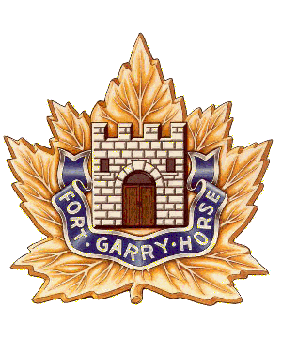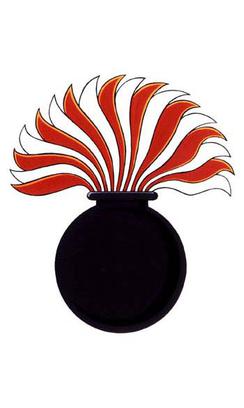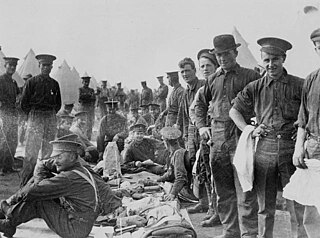Related Research Articles

The Fort Garry Horse is a Canadian Army Reserve armoured regiment based in Winnipeg, Manitoba, Canada. It is part of 3rd Canadian Division's 38 Canadian Brigade Group. It traces its history to a cavalry regiment first formed in 1912 that first took up the name "Fort Garry" a year afterwards. Since that time the regiment has served in the First World War, sending men to battalions of the Canadian Expeditionary Force, and as an armoured regiment in the Second World War.

The Royal Winnipeg Rifles are a Primary Reserve one-battalion infantry regiment of the Canadian Army. Nicknamed the "Little Black Devils", they are based at Minto Armoury in Winnipeg, Manitoba. The Royal Winnipeg Rifles are part of 3rd Canadian Division's 38 Canadian Brigade Group.
The 183rd Battalion, CEF was a unit in the Canadian Expeditionary Force during the First World War. Based in Winnipeg, Manitoba, the unit began recruiting during the winter of 1915/16 throughout the Province of Manitoba. After sailing to England in October 1916, the battalion was broken up in November 1916 and its men transferred to the following units: 100th Battalion, CEF, 107th Battalion, CEF, 108th Battalion, CEF, and the 144th Battalion, CEF. The 183rd Battalion, CEF had one Officer Commanding: Lieut-Col. W. T. Edgecombe.

The 144th Battalion, CEF was a unit in the Canadian Expeditionary Force during the First World War. Based in Winnipeg, Manitoba, the unit began recruiting in late 1915 in that city. After sailing to England in September 1916, the battalion was absorbed into the 18th Reserve Battalion on January 12, 1917. The 144th Battalion, CEF had one Officer Commanding: Lieut-Col. A. W. Morley.
The 203rd Battalion, CEF was a unit in the Canadian Expeditionary Force during the First World War. Based in Winnipeg, Manitoba, the unit began recruiting during the winter of 1915/16 in that city. After sailing to England in October 1916, the battalion was absorbed into the 18th Reserve Battalion on January 12, 1917. The 203rd Battalion, CEF had one Officer Commanding: Lieut-Col. Jeffrey E. Hansford.
The 226th Battalion, CEF was a unit in the Canadian Expeditionary Force during the First World War.

The Winnipeg Grenadiers was an infantry regiment of the Canadian Army.

Permanent Active Militia (PAM), also known as Permanent Force (PF), was the proper name of Canada's full-time professional land forces from 1855 to 1940, when it was reorganized into the Canadian Army. PAM was in effect Canada's standing army, consisting of one regular infantry regiment and two cavalry regiments in 1914.

The 12th Manitoba Dragoons is an armoured regiment of the Canadian Army that is currently on the Supplementary Order of Battle.
The 27th Battalion, CEF was an infantry battalion of the Canadian Expeditionary Force during the First World War. The battalion was authorized on 7 November 1914 and embarked for Great Britain on 17 May 1915. It disembarked in France on 18 September 1915, where it fought as part of the 6th Infantry Brigade, 2nd Canadian Division in France and Flanders until the end of the war. The battalion was disbanded on 15 September 1920.

The 78th Battalion, CEF was an infantry battalion of the Canadian Expeditionary Force during World War I. The 78th Battalion was authorized on 10 July 1915 and embarked for Great Britain on 20 May 1916. It disembarked in France on 13 August 1916, where it fought as part of the 12th Brigade, 4th Canadian Division in France and Flanders until the armistice. The battalion was disbanded on 15 September 1920.
The Winnipeg Light Infantry was an infantry regiment of the Non-Permanent Active Militia of the Canadian Militia. In 1955, the regiment was amalgamated with The Royal Winnipeg Rifles.

The 11th Battalion, CEF, an infantry battalion of the Canadian Expeditionary Force, was authorized on 10 August 1914 and embarked for Great Britain on 30 September 1914. It was redesignated as the 11th Reserve Infantry Battalion, CEF, on 29 April 1915, to provide reinforcements to the Canadian Corps in the field. On 4 January 1917, its personnel, along with the personnel of the 100th Battalion, CEF, were absorbed by a new 11th Reserve Battalion (Manitoba), CEF. The battalion was disbanded on 12 October 1917.

The 8th Battalion, CEF, also known by the nickname of The Little Black Devils of Canada, was an infantry battalion of the Canadian Expeditionary Force during the Great War. The battalion was authorized on 10 August 1914 and embarked for Great Britain on 1 October 1914. It disembarked in France on 13 February 1915, where it fought as part of the 2nd Canadian Brigade, 1st Canadian Division in France and Flanders until the end of the war. The battalion was disbanded on 15 September 1920.

The 43rd Battalion, CEF, was an infantry battalion of the Canadian Expeditionary Force during the Great War.

The 44th Battalion (Manitoba), CEF, was an infantry battalion of the Canadian Expeditionary Force during World War I.
The 61st Battalion (Winnipeg), CEF was an infantry battalion of the Canadian Expeditionary Force during the Great War. The 61st Battalion was authorized on 20 April 1915 and embarked for Great Britain on 5 April 1915. It provided reinforcements to the Canadian Corps in the field until 6 July 1916, when its personnel were absorbed by the 11th Reserve Battalion, CEF. The battalion was subsequently disbanded on 17 July 1917.

The 90th Battalion, CEF, was an infantry battalion of the Great War Canadian Expeditionary Force. The 90th Battalion was authorized on 22 December 1915 and embarked for Great Britain on 31 May 1916, where on 19 July 1916 its personnel were absorbed by the 11th Reserve Battalion, CEF, to provide reinforcements to the Canadian Corps in the field. The battalion disbanded on 1 September 1917.

The 100th Battalion, CEF, was an infantry battalion of the Great War Canadian Expeditionary Force.

The 101st Battalion, CEF, was an infantry battalion of the Great War Canadian Expeditionary Force. The 101st Battalion was authorized on 22 December 1915 and embarked for Great Britain on 29 June 1916, where, on 13 July 1916, its personnel were absorbed by the 17th Reserve Battalion, CEF, to provide reinforcements to the Canadian Corps in the field. The battalion disbanded on 12 October 1917. It was recruited in, and was mobilized at, Winnipeg, Manitoba.
References
- ↑ Hume, Stephen. "Casualties Went Far Beyond the Front Line". Vancouver Sun. Retrieved June 23, 2022– via PressReader.
- ↑ Canadian Forces Publication A-DH-267-003 Insignia and Lineages of the Canadian Forces. Volume 3: Combat Arms Regiments.
Meek, John F. Over the Top! The Canadian Infantry in the First World War. Orangeville, Ont.: The Author, 1971.